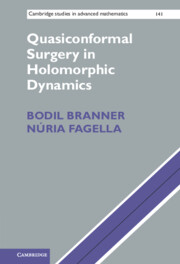Book contents
- Frontmatter
- Dedication
- Contents
- List of contributors
- Preface
- Acknowledgements
- List of symbols
- Introduction
- 1 Quasiconformal geometry
- 2 Boundary behaviour of quasiconformal maps: extensions and interpolations
- 3 Preliminaries on dynamical systems and actions of Kleinian groups
- 4 Introduction to surgery and first occurrences
- 5 General principles of surgery
- 6 Soft surgeries
- 7 Cut and paste surgeries
- 8 Cut and paste surgeries with sectors
- 9 Trans-quasiconformal surgery
- References
- Index
7 - Cut and paste surgeries
Published online by Cambridge University Press: 05 February 2014
- Frontmatter
- Dedication
- Contents
- List of contributors
- Preface
- Acknowledgements
- List of symbols
- Introduction
- 1 Quasiconformal geometry
- 2 Boundary behaviour of quasiconformal maps: extensions and interpolations
- 3 Preliminaries on dynamical systems and actions of Kleinian groups
- 4 Introduction to surgery and first occurrences
- 5 General principles of surgery
- 6 Soft surgeries
- 7 Cut and paste surgeries
- 8 Cut and paste surgeries with sectors
- 9 Trans-quasiconformal surgery
- References
- Index
Summary
In this chapter we treat several different applications of cut and paste surgery. The general principle is to paste together dynamics of different maps, under the condition that they agree on the boundaries of their distinct domains of definition.
Section 7.1 explains one of the earliest uses of quasiconformal mappings in holomorphic dynamics, due to Douady and Hubbard. It is especially relevant as a building block in many other applications. This celebrated result justifies why polynomial Julia sets appear in the dynamical plane of many non-polynomial families. The parameter version of the Straightening Theorem explains why one can also find copies of the Mandelbrot set in parameter spaces other than that of the quadratic family.
Section 7.2 groups several classical results about Siegel discs under one common surgery, due to Ghys. The construction consists in pasting a rigid irrational rotation on a topological disc bounded by an invariant quasicircle: the gluing curve. With this construction one shows, for example, that a Siegel disc of a quadratic polynomial with rotation number of bounded type is a Jordan domain containing the critical point on the boundary.
Section 7.3 is dedicated to a construction due to Shishikura, where two rational maps with Siegel discs of a given rotation number are pasted together along an invariant curve, resulting in a map with a Herman ring of the same rotation number. This construction explains, for example, the possible classes of irrational numbers that can be realized as rotation numbers of actual Herman rings.
- Type
- Chapter
- Information
- Quasiconformal Surgery in Holomorphic Dynamics , pp. 218 - 306Publisher: Cambridge University PressPrint publication year: 2014



